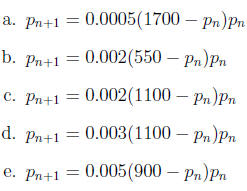Another Worksheet for Logistic Growth
Summary and expansion of discussion in the book: In a logistic growth model,
calculate mL:
Then one of the following cases must apply:
• If mL ≤ 1 the population will die off for any initial population size between 0 and L:
• If 1 < mL ≤ 3 the population will level off eventually, for any initial
population size
between 0 and L. The steady population size will be L - 1/m.
• If 3 < mL ≤ 4, the population may not level off. However, you can be sure
that the model
will always produce population values that stay between 0 and L; provided the
initial
population size is between 0 and L:
• If mL > 4; the model may eventually produce negative values for population
size. This is
invalid and shows that the model is unreliable for future predictions.
1. In the first logistic growth worksheet, you were supposed to develop
logistic growth models for
growing mold in a laboratory under a variety of conditions. The difference
equations that you
should have found are shown below. For each one, use the results of the logistic
growth chapter
to decide if the population eventually dies out, levels off, remains valid
without leveling off, or
eventually leads to negative (and so invalid) predicted population sizes.

2. For model c above, investigate the effect of harvesting various amounts
from the model. For
example, if you harvest 100 members of the population from each cycle, the
difference equation
will become

Describe what will happen to this population over the long term. Does it
matter what the
starting population is?
3. Repeat the preceding problem using a harvest of 160, then of 200.
Summary and expansion of discussion of harvesting: In a logistic growth model
with harvesting,
the difference equation has the following form:

where h is the amount harvested for each cycle. The long term behavior of
this model is determined
by the roots of the equation

which are the fixed points of the model. To find them, express the equation in the form

and use the quadratic formula. Generally there are two roots, which can be
referred to as LFP
(for lower fixed point) and HFP (for higher fixed point). If these are both
between 0 and L,
then the following conclusions hold:
• If the initial population is any number between LFP and L - LFP, the model
will eventually
level off and remain at a size equal to HFP.
• If the initial population is between 0 and LFP the model will decrease and
eventually
become negative.
• If the initial population is between L-LFP and L the model will decrease
and eventually
become negative.
• If there are no roots to the equation above, the model will decrease and
eventually become
negative no matter what the starting population size is.
For each of the problems with harvesting on the preceding page, find LFP, HFP,
and L-HFP.
Use the summary above to analyze the future behavior of the model, and compare
with the results
you found for problems 2 and 3 earlier.


